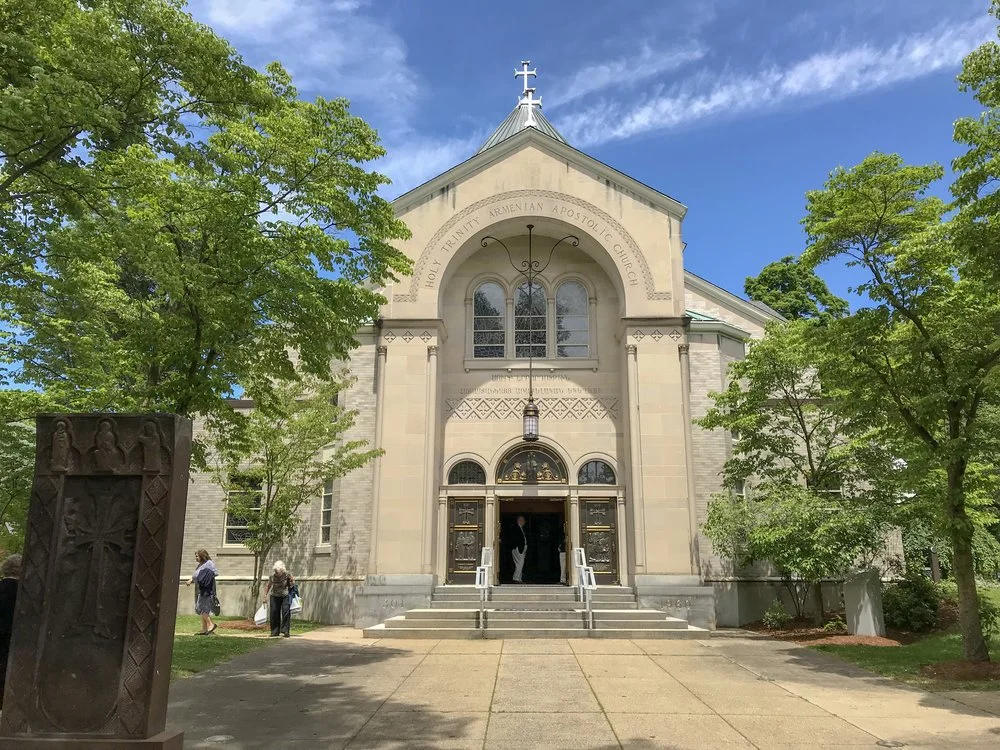Armenians of Boston, Massachusetts and surrounding area
ADS 2018 Pilot project
Armenian Festival at St James organizers. Watertown. (Photo Credit: Susan Pattie)
The City of Boston is characterised by its beautiful natural setting on the Atlantic coast with the Charles River cutting through to the port. Historic sites dating to the American Revolution are found throughout the city and surrounding towns. Greater Boston also hosts numerous world-class universities, colleges and conservatories. A “sports-mad” town, Boston’s teams are regularly national champions.
Holy Trinity Church, Cambridge. (Photo Credit: Chloe Barran)
There are an estimated 30-50 thousand Armenians in the Greater Boston area.
The first Armenians to settle in the East Coast of the United States in the late 19th and early 20th centuries clustered around industrial towns with the most employment opportunities: Worcester, Lawrence, Whitinsville, Providence, Boston, Philadelphia and New York. Since the establishment of the very first Armenian communities in this region, they have been characterised by core institutions: churches, libraries, coffeehouses, boarding houses and community centres. In the early years of the development of these communities, people’s ethnic identities superseded their regional or local identities: bourgeois immigrants from Istanbul would intermingle with villagers from the Kharpert region of historic Armenia.
As there were restrictions to owning property and finding employment, the Armenians congregated in areas where they could find accommodation and jobs. In Lawrence, they settled on Common Street, close to the American Woolen Company. In Whitinsville, they lived on Main Street. In Worcester, they settled on Dewey, Mason and Chandler streets as well near Harrington Richardson Arms and Wiley Bickford factories, where many Armenians worked. In Providence, Armenians were attracted by job opportunities at the American Wire Company, so settled on the nearby Chalkstone Street and Douglas Avenue.
As for larger business centres like Boston, Armenians engaged in small businesses: tailor shops, shoemaking, rug repair stores, jewellery and grocery shops. Kneeland Street marked a dividing point between the businesses and people’s homes.
In time, people began to move from industrial to suburban areas. The growth of chain businesses in the 1960s and ‘70s affected the small-scale businesses which Armenians owned. New generations created other kinds of businesses and many Armenians began to enter the professions. Numerous Armenians have been involved in civic life, some holding political office. More recently, Boston has become a tech innovation and entrepreneurial centre. Meanwhile, Armenians have become more dispersed and have moved, for example, from Watertown to Newton, Winchester, Haverhill, and further.
In recent decades, the descendants of these communities have regrouped, thanks to the memories of their ancestors passed down to them. Changes and developments over the decades have given birth to new kinds of diasporic community centres in the Greater Boston area, such as the National Association for Armenian Studies and Research (NAASR), the Armenian Museum of America, the Armenian Cultural Foundation, the Armenian International Women’s Association, Project SAVE Armenian Photograph Archives, a branch of the Armenian Assembly, and the beautiful Armenian Heritage Park with its Genocide memorial in downtown Boston.
Institutions, old and new, continue to serve as gathering places for Armenians of the region. There are several Armenian religious centres located in the Boston area, including Armenian Apostolic, Catholic and Protestant churches. In addition, there are also schools, dance and music classes, regular festivals and dinners, professional organizations, charities, such as the Armenia Tree Project, Knights and Daughters of Vartan, the Cambridge-Yerevan Sister City Association, active since 1987, and others.
Armenian political activity has been a substantially important part of community life in Boston. All three major Armenian diasporan political parties, ARF, SDHP and ADL, have played significant roles in running educational, cultural and sports activities in the Boston area. Boston reaches beyond its community borders through the wide reach of two newspapers based in Watertown: the Armenian Mirror Spectator and the Armenian Weekly, read across the Anglophone world, both in print and online.

